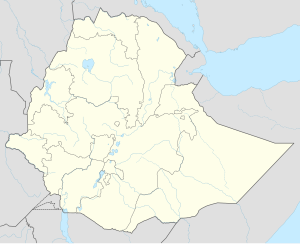The United Nations Educational, Scientific and Cultural Organization (UNESCO) World Heritage Sites are places of importance to cultural or natural heritage as described in the UNESCO World Heritage Convention, established in 1972.[1] Cultural heritage consists of monuments (such as architectural works, monumental sculptures, or inscriptions), groups of buildings, and sites (including archaeological sites). Natural features (consisting of physical and biological formations), geological and physiographical formations (including habitats of threatened species of animals and plants), and natural sites which are important from the point of view of science, conservation, or natural beauty, are defined as natural heritage.[2] Ethiopia accepted the convention on 6 July 1977.[3] There are 11 World Heritage Sites in Ethiopia, with a further seven on the tentative list.[3]
The first two sites in Ethiopia added to the list were the Rock-Hewn Churches, Lalibela, and the Simien National Park, both at the Second Session of the World Heritage Committee, held in Washington, D.C., in 1978.[4] The most recent sites listed were the Gedeo Cultural Landscape and Bale Mountains National Park, in 2023.[3] Simien and Bale Mountains are natural sites while the other nine sites are listed for their cultural significance.[3] In 1996 Simien was listed as endangered because of the impact of a new road across the property, excessive cattle grazing, agricultural encroachment, and a drop in the number of populations of large mammals. Following improvements in management and recovering animal communities, the site was removed from the endangered list in 2017.[5] Ethiopia has served as a member of the World Heritage Committee twice: 2009–2013 and 2019–2023.[3]
- ^ "The World Heritage Convention". UNESCO World Heritage Centre. Archived from the original on 27 August 2016. Retrieved 7 July 2019.
- ^ "Convention Concerning the Protection of the World Cultural and Natural Heritage". UNESCO World Heritage Centre. Archived from the original on 1 February 2021. Retrieved 3 February 2021.
- ^ a b c d e "Ethiopia". UNESCO World Heritage Centre. Archived from the original on 5 January 2021. Retrieved 14 September 2022.
- ^ "Report of Rapporteur" (PDF). UNESCO World Heritage Centre. Archived (PDF) from the original on 16 October 2013. Retrieved 14 September 2012.
- ^ "Ethiopian World Heritage site, Simien National Park no longer in danger". UNESCO World Heritage Centre. Archived from the original on 6 October 2022. Retrieved 14 September 2022.
